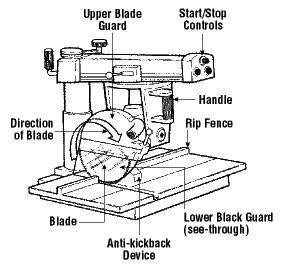Woodworking Machines - Radial Arm Saws
On this page
What should you do before using a radial arm saw?
Back to topA radial arm saw can be dangerous if not used properly.
- Read the owner's manual carefully.
- Make sure you understand instructions before attempting to use any tool or machine.
- Learn the applications and limitations before use.
- Refer to Woodworking Machines - General Safety Tips for general safety precautions.
What safety procedures should you follow when using a radial arm saw?
Back to top- Wear safety glasses with side shields or safety goggles, or a face shield (with safety glasses or goggles).
- Wear hearing protection that is suitable for the level and frequency of the noise you are exposed to in the woodworking area.
- Wear protective footwear, when required.
- Wear respiratory protection, when required.
- Feed stock against the direction of the blade (the blade should move downward when viewed by the operator).
- Operate the blade at speeds recommended by the manufacturer.
- Use only the accessories designed for that specific saw and application.
- Make sure fences and any other guards are properly adjusted and in place before using the machine.
- Ensure the guard consists of two parts:
- Upper hood type that covers arbour
- Lower guard that rides on the stock, adjusting automatically to the thickness being cut.
- Stand on the handle side when cross cutting. Pull the cutting head with the hand nearest the handle and maneuver the stock with the other hand.
- Make sure the hand holding the stock is never in line with the blade.
- Return the cutting head completely to the back of the saw table after each cut. The saw should be designed so that the blade will not move forward under its own weight or if the machine is vibrating.
- When ripping, make sure that the overall length of the saw table (both infeed and outfeed) is twice the length of the longest pieces of lumber.
- When ripping, make sure that the stock is fed against the direction of the blade (from the side where the saw blade rotates upward toward the operator). The blade should extend slightly into the table. The motor head must be locked at the correct height and angle.
- Make sure that the cutting table is wide enough so that no part of the saw blade overhangs the front edge of the table.
- Clamp stock to the table on one side of the saw blade, when making mitre, bevel or compound mitre cuts. Clamping prevents the wood from sliding along the fence during the cut.
- Turn off the saw and unplug the electricity when making any adjustments or changes in the set up.
- When taking measurements, turn off the saw and place the wood to be cut against the stop gauge.

What should you avoid when working with a radial arm saw?
Back to top- Do not cut the stock that has loose knots, splits, defects or foreign objects (e.g., metal stone) in it.
- Do not use radial arm saws for ripping unless the spreader (riving knife) and anti-kickback devices are provided and properly adjusted.
- Do not take your hand away from the operating handle unless the cutting head is behind the fence.
- Do not remove the stock from a saw table until the blade has been returned to its "resting" position at the back of the saw table. Use a stick or brush to remove scrap from the saw table.
- Do not cut "free hand". Use the back guide or fence, or other device to keep the workpiece from moving.
- Do not use cracked or dull blades.
- Do not leave a running saw unattended – leave only after the saw has been turned off and it has come to a complete stop.
- Do not wear loose clothing, work gloves, neckties, rings, bracelets or other jewellery that can become entangled with moving parts.
- Fact sheet last revised: 2019-08-09
